What does it mean when we do it like this?
"You Who Read Me with Passion Must Now Forever Be My Friends" arrives at a moment when women decades younger than Iannone need someone to show them out of this maze.
By Catherine WagleySeptember 19, 2015
You Who Read Me With Passion Now Must Forever Be My Friends by Dorothy Iannone. Siglio. 320 pages.
ALL BUT ONE of the recommendations on the book jacket of Dorothy Iannone: You Who Read Me With Passion Now Must Forever Be My Friends (Siglio Press, 2014) are written by women, most around 50 years younger than the dauntless artist who is the book’s subject. Michelle Tea, who once wrote a novel in which a tough-girl uses a tampon as a weapon (Rose of No Man’s Land, 2006), likens reading Dorothy Iannone (b. 1933, Boston) to joining a “conspiracy of beauty and romantic obsession.” Ariana Reines, who muses about women who are “beyond themselves” in the same book-length poem in which she describes hacking into an ex’s email account (Coeur de Lion. 2nd ed. Albany, New York: Fence Books, 2011), says Iannone will “lead us out of the labyrinth, then let us share in her bliss.” Blurbs are supposed to be hopelessly enthusiastic but there’s something particularly telling about the slant that these take, presenting Iannone as a conspiratorial leader, a kind of liberator. The younger women want her to guide them to a place where patriarchy is nothing more than a distraction, and amorousness and inquisitiveness both have respected status.
The book includes paintings, drawings, and text from four decades of Iannone’s life as an artist. Like an artists’ book or graphic novel, it is intended to be experienced not as a record of production but as a work of its own. The book’s editor and the founder of Siglio Press, Lisa Pearson, previously included Iannone in Siglio’s 2011 book It Is Almost That: A Collection of Image+Text Work by Women Artists & Writers. Pearson told me that, working on that volume, she realized that Iannone’s art and artists’ books were difficult to find — and to read (Iannone’s handwritten text can be challenging to make out in reproduction). The first major museum retrospective on Iannone’s work opened February 2014, at the Berlinische Galerie in Berlin (she’s had smaller shows, such as at the New Museum in 2009), so there aren’t many exhibition catalogs available, either.
Pearson assembled the book thematically rather than chronologically, providing a cohesive arc to the ideas. It begins with Iannone’s autobiographical story of awakening, An Icelandic Saga, followed by her experimental cookbook, the tarot-card-like Ten Scenes, and a fictional story about brothers whose domineering father turns them into wispy, white-haired girls. Though a brief introduction by Pearson opens the book and an involved essay by poet-writer Trinie Dalton ends it, no commentary interrupts the presentation of Iannone’s art. The borders around the text are thin and the page numbers are included on the sides, so as not to intrude on the content. Because the book does not seem to be about but of Iannone, it presents an ideal opportunity to ask: Why does the 82-year-old artist feel so relevant and sage-like to women decades younger? What is she offering that we feel we need?
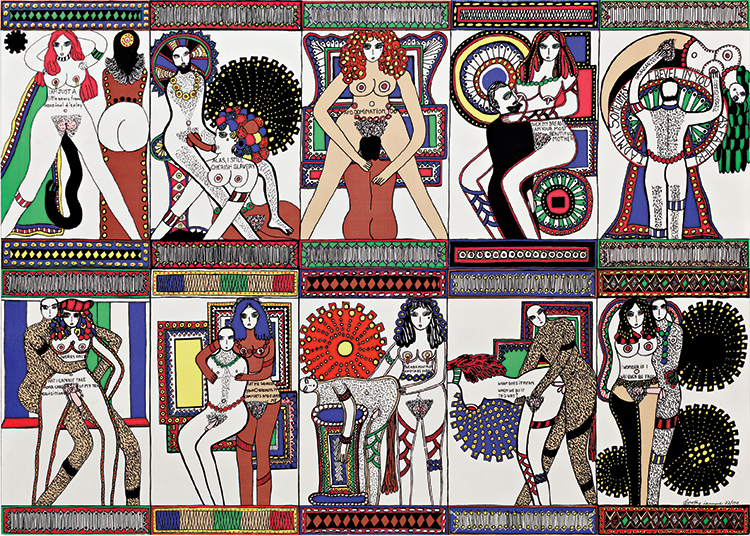
“Ten Scenes,” 1969 by Dorothy Iannone, in You Who Read Me
With Passion Now Must Forever Be My Friends, Siglio, 2014.
Courtesy of the artist, Air de Paris, Paris. Photo Hans-Georg Gaul.
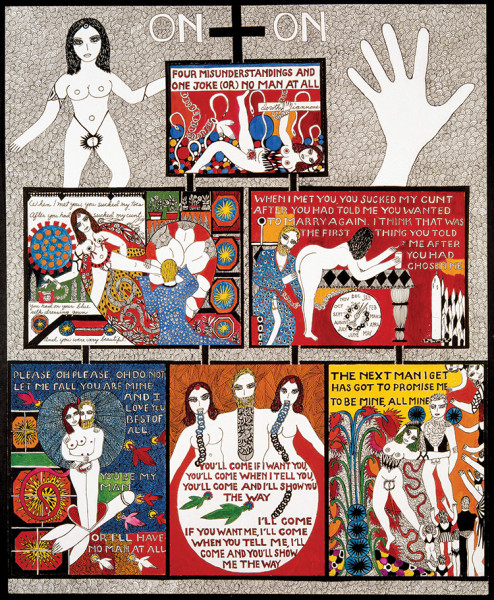
“On+On,” 1979 by Dorothy Iannone, in You Who Read Me With
Passion Now Must Forever Be My Friends, Siglio, 2014.
Courtesy of the artist, Air de Paris, Paris and Nationalgalerie /
Staatliche Museen zu Berlin.
The first time I stumbled upon an exhibition of Iannone’s work, at Peres Projects in 2010, then located in Los Angeles (the gallery has since left the city), I assumed that she was young. The way her work embraced an ornate folk aesthetic and presented sexuality so casually — two kissing cowboys; a woman in orgasm; genitals unassumingly everywhere; flourishes that recalled tapestries or illuminated manuscripts — showed a kinship with women who came of age in the 1980s or ’90s. I thought of Tracey Emin, Shahzia Sikander, or Kara Walker, all artists who were comfortable with formerly stigmatized confessional and crafty modes. In fact, Iannone’s better-known contemporaries include Helen Frankenthaler and Lee Krasner, female painters who participated in the abstract expressionist moment, adding their own version of ballsiness to the conversation without necessarily defying the dominant visual vocabulary.
Iannone tried her hand at abstract expressionism, too, but in an interview with curator Dirk Dobke published in Dieter Roth & Dorothy Iannone (Berlin: Holzwarth Publications, 2005) she explained that, in her paintings, “One day, a man and woman in an enclosed space appeared among the abstract elements.” She had drawn them with her fingers. “Clearly visible genitals were already present, indeed very prominent,” she recalled. Soon she had transitioned to ornate tapestry-like paintings, and then to wood cutouts of voluptuous figures with prominent sexual organs. “It all happened very naturally,” she told Dobke, “one thing led rapidly to another.”
By 1967, Iannone had already begun incorporating text into her paintings and cutouts. There is a scene early on in An Icelandic Saga, the 1978 love story she based on a voyage by sea to Iceland with then-husband James Upham and friend, Fluxus artist Emmett Williams, in which Iannone describes going to a deserted ship saloon one evening. In the story, she describes herself as in a particularly enlightened mood, Emmett as well. He lights a dollar bill on fire; James is disgusted and storms out, expecting his wife to follow. But Iannone does not — not right away. It is in the context of this subtle defiance, the first in a series of such subtle acts of defiance, that she issues the assertive but vulnerable pronouncement that becomes Siglio’s title for the book: You Who Read Me With Passion Now Must Forever Be My Friends.
The Icelandic Saga may be Iannone’s best-known series. Perhaps it owes its popularity to its satisfying story line and to the fact that it prominently features Swiss artist Dieter Roth, whose work was and remains well known (he was a jack-of-all-trades who, according to the press release for a 2013 MoMA exhibition of his work, “offered an expanded definition of art in the twentieth century”). The first installment of An Icelandic Saga appeared as black-and-white panels in 1978, 11 years after her affair with Roth began. It chronicles Iannone’s transition from a postwar American wife who, in her words, “found infidelity unfamiliar” to a self-reliant expat.
In the panels she drew at the start of An Icelandic Saga, Iannone usually rendered herself as a dark-haired woman with curious, mysterious eyes and exposed breasts. But when she returned to the project in 1983, further illustrating the early stages of her love affair with Roth, she took more liberties in depictions of herself. On the page describing the “harsh sexual proposal” Dieter made before laying his head on her lap, the image of her torso is filled with drawings of his round, oval-eyed, scruffy head: two heads in place of her breasts and one each in place of the buttocks, thighs, and knees. “One head in the lap is worth two in the hand,” she writes below her figure, in letters made up of bead-like circles. On a subsequent page, her image appears leaning to one side, face decorated with little circles, a cross on her chest, a spidery black plant growing between her legs, and a halo of ornate pillows surrounding her. Here, as she writes, her body calls “attention to the turmoil it had to endure as her soul was breaking forth into the unknown.” And, a few days later, she recalls making love with her husband for the last time — depicting their bodies beneath a curtain shaped like a circus tent — with gusto, “honoring the past and embracing the future she was filled with love for everyone.” Perhaps this is where the turning point of You Who Read Me begins, 50 pages in, as Iannone becomes a woman easing her way into a radicalism that is both aesthetic and ideological.
The stories of unorthodox women of Iannone’s generation, and even a decade or two younger, are too often tragic. Think of Shulamith Firestone, who in 1970 wrote The Dialectic of Sex. She thought that feminism meant deconstructing and then reconstructing public and private conventions, fully lived what she believed, and then died alone, possibly of starvation, after years battling schizophrenia. Susan Faludi’s 2013 profile of Firestone in The New Yorker magazine, “Death of a Revolutionary”, describes her funeral as an event where mourners not only recognized the loss of an icon but also the loss of a whole generation of women who “had been unable to thrive in the world they had done so much to create.” Artist Lee Lozano, who made work that entirely blurred the life-art divide and treated everything from romance to the idea of success as ripe for revision, spent the last two decades of her life living on the edge in Texas, battling mental illness. Eve Babitz’s writing from the 1970s has a flip, confident sexuality that shows complete disregard for ideas of what a respectable feminist writer should be. (She dedicated her book Eve’s Hollywood to the much more reserved writer, Joan Didion, and her husband, “for having to be who I’m not.”) She lives reclusively somewhere in West Hollywood and hasn’t written since the mid-1990s. There are more stories like this, of women who defied dominant visual or verbal tropes and then, through a diverse mess of circumstances, ended up on the fringes. But the healthy, wholesome, confidently vulnerable woman who makes doggedly pursuing the sensual kind of world she wants seem fruitful rather than irresponsible and potentially damaging, is much harder to find.
When he interviewed Iannone, Dobke asked her whether living with Roth impacted her art and she answered without hesitation that it did not: “If you already have your own way of working, you don’t want to give it up for someone else’s way of working.” Artist Jan Voss, close to Iannone during the years she and Roth spent in Düsseldorf, said of her in Dorothy Iannone: This Sweetness Outside of Time (Berlinische Galerie, 2014), “Dorothy has been for all the time I’ve known her an incarnation of all revolutionaries. She determined herself which hierarchies she would acknowledge and which to laugh away.” Often, her work was excluded or censored from exhibitions. In 1967, police raided an exhibition of hers in Stuttgart, Germany. Then, in 1969, right before a group show opened at Kunsthalle Bern, curator Harald Szeemann put brown tape over the genitals of the figures in her drawings. Considering such roadblocks to even exhibiting her art as it was meant to be seen, it’s not surprising that she also had trouble finding buyers. “Her imagery is too bright for the market, so she has enormous difficulties to make a living (not like we fog-bombs and greylings),” Roth said of Iannone in 1997.
In a 1971 etching that appears in You Who Read Me, Iannone laments, “I’m so weary of patriarchy / Oh Ariadne come show the way / Let’s go where the lively reveled.” The imagery, a psychedelic array of circles and squares, depicts a woman and man (Dorothy and Dieter?) fending off lions in a forest before making love. The man soothes the lion by playing a trumpet and the woman “augments,” as Iannone’s text puts it, with her voice. The border around the etching makes the whole scenario feel claustrophobic. “I think I’m yearning for matriarchy, Oh Ariadne,” she writes. The etching appears in the book after An Icelandic Saga and a few pages before A Cookbook, a colorful artist book Iannone made in 1969 that combines handwritten recipes with stream-of-consciousness commentary on Roth’s wanderlust, the difficulties of self-love, and the nature of god (“maybe god would do best to be a hermaphrodite”). Often, the commentary appears as if a sidenote or addendum to a given recipe. “It depresses a philanderer to hear how much your wife enjoys you in bed,” she writes in red, black, and yellow pen in the midst of a recipe for Minute Butter. Later, over recipes for Sauce Madeira and Chicken Liver Pâté, she writes that she will not marry Roth after all. She does not think she wants to anymore. “How come almost no one admires me for my no marriage stance?” she asks, using yellow behind red and black this time, too, so the letters appear to glow. Again, the status quo is in her way.
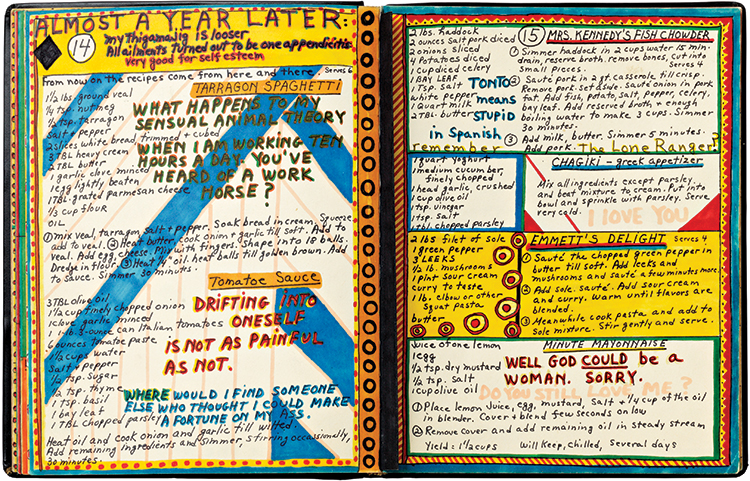
Excerpt from “A Cookbook,” 1969 by Dorothy Iannone, in You Who Read
Me With Passion Now Must Forever Be My Friends, Siglio, 2014.
Courtesy of the artist, Air de Paris, Paris. Photo Hans-Georg Gaul.
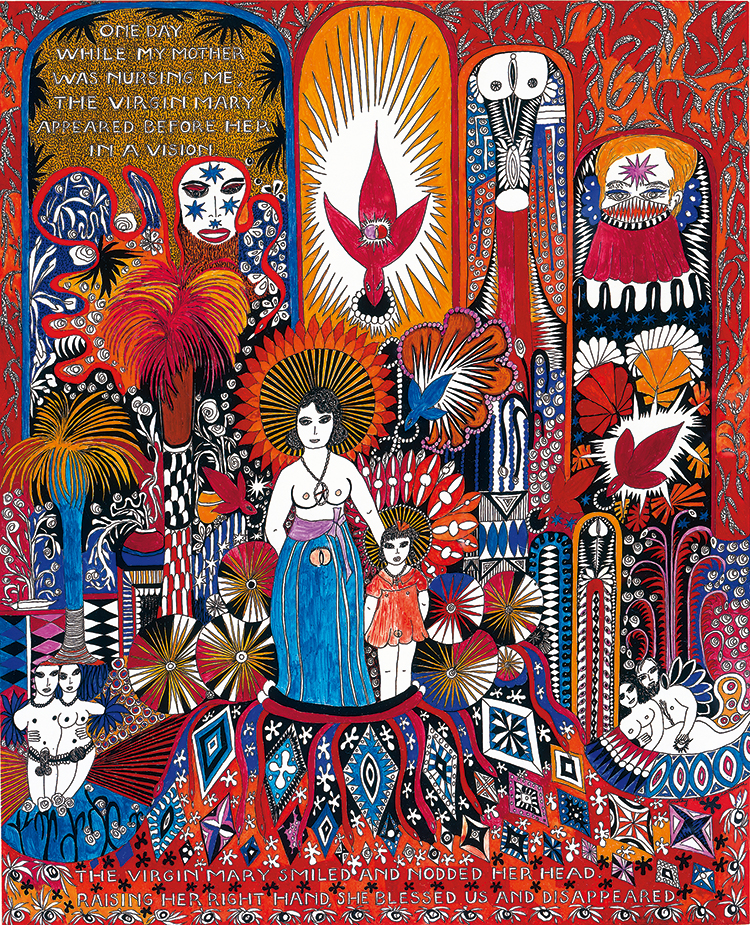
“Mother And Child,” 1980 by Dorothy Iannone, in You Who Read
Me With Passion Now Must Forever Be My Friends, Siglio, 2014.
Courtesy of the artist, Air de Paris, Paris and the Ahlers Collection.
Iannone left Roth in 1974, moving from Düsseldorf to the South of France. Almost a decade later, she would write, perhaps about Roth or perhaps another lover, “Somewhat discouraged by your ever renewed rejection of the ecstatic unity we are capable of experiencing together, […] I continue my path toward that realization, but this time, beloved, without you.” (Dieter Roth & Dorothy Iannone, Holzwarth Publications, 2005). The drawings that follow A Cookbook in You Who Read Me were actually made slightly earlier, between 1967 and 1969, but they show Iannone questioning with increased intensity. In Ten Scenes, a series of 10 paintings, she depicts herself and Roth in different sexual positions, querying with her text what each of these says about gender and power. “What does it mean when we do it like this?” reads the text across her body in an image in which she’s depicted herself leaning on an ornate purple cushion as a particularly hairy version of Roth penetrates her from behind.
The drawings made after she and Roth part ways pose wider and more aspirational questions. The series An Explosive Interlude, 1979, was made after she had returned to Berlin. These black-and-white drawings, slightly more subdued than previous works, explore the reasons she chose to stay in Germany, where men protect their masculinity to a fault and “say no because everyone else was saying no.” Germany’s galleries said no to putting her work on their walls, she suggests, because doing so would have affirmed that they valued love and sexuality. As she writes in text lining a particularly vaginal-shaped oval: “Who can afford such an affirmation in these mechanical days without faith, without opulence, in these dog days where the oceanic striving evokes a condescending smile …?”
Interest in Iannone began to grow around the same time that 32-year-old Ariana Reines published her book of poetry Coeur de Lion (2007), the incisive rant of a woman who perhaps feels more stifled by the triteness of art and the reach and residue of patriarchy than Iannone had decades earlier. The narrator, Reines’s “I,” expresses that she feels nerdy, too emotional, and too enthusiastic but just as ravenous as Iannone. “I fall for women,” Reines writes, “Who are beyond themselves, you, their situation, and everything. Those are the women I want to know about. Those are the women I want to know.” No wonder that, when she read You Who Read Me, she fell for its author.
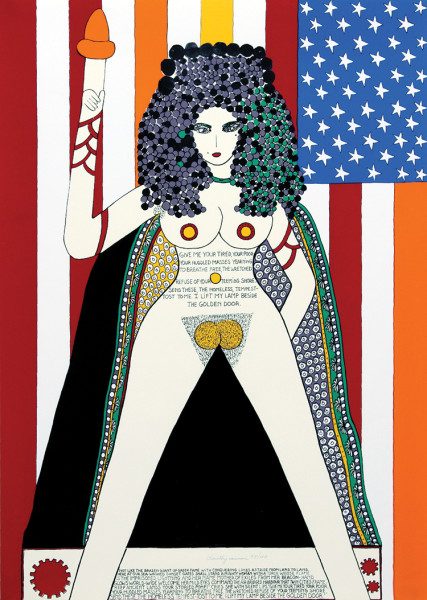
“The Statue Of Liberty,” 1977 by Dorothy Iannone, in You Who Read
Me With Passion Now Must Forever Be My Friends, Siglio, 2014.
Courtesy of the artist, Air de Paris, Paris. Photo Marc Domage.
Sheila Heti, a Toronto-based writer, finished her book How Should a Person Be? in 2012, when she was 38 years old. In the book — Heti calls it a “novel from life” — men often explain things to her and she experiences shame and confusion about having casual sex. But then she finds a kind of liberation in friendship with a woman who cares less than Heti does about what others think. Reviewers kept comparing Heti’s book to Lena Dunham’s HBO show Girls, perhaps unfairly. But that show does indeed deal with the challenge of wanting to be independent, creative, and feminine while feeling limited by expectations of what a woman should want or be. “Let Power Take a Female Form” is the title of an exhibition that artist Corazon del Sol, influenced by Iannone since childhood, organized for the Los Angeles gallery The Box (June 27–August 8, 2015). The title, based on an artwork by del Sol’s mother, artist, author, and activist Eugenia P. Butler, is a call for action and a question. It’s still not really clear what feminine power looks like, given that the fog-bombs and greylings (the names Roth gave the old boys) still dominate the art market and sleekness and minimalism have proven to have more staying power than performances of vulnerability.
You Who Read Me with Passion Must Now Forever Be My Friends arrives at a moment when women decades younger than Iannone need someone to show them out of this maze. Iannone’s been trying, quite overtly, to rally followers for years. As she wrote in 1977, yet again addressing a hesitant man: “Follow me, […] You who have tried to refuse to be whole beings /Abandon your reign before our promise goes under. / Follow Me. / Follow Me.”
¤
LARB Contributor
Catherine Wagley writes about art and visual culture in Los Angeles. She currently works as an art critic for LA Weekly and contributes to a number of other publications, most recently CARLA, X-TRA, Photograph Magazine, and East of Borneo. She also teaches courses on experimental 20th- and 21st-century art and music at University of LaVerne in collaboration with concert pianist Dr. Grace Zhao.
LARB Staff Recommendations
You Tell Me It’s the Institution: Creative Writing and Literary History
Kenneth W. Warren discusses "The Program Era."
Inconvenient Truths at LACMA: Sweeping Debt, Dealmaking, and Dubious Design under the Red Carpet
Did you know LARB is a reader-supported nonprofit?
LARB publishes daily without a paywall as part of our mission to make rigorous, incisive, and engaging writing on every aspect of literature, culture, and the arts freely accessible to the public. Help us continue this work with your tax-deductible donation today!